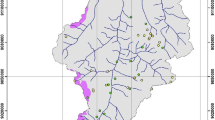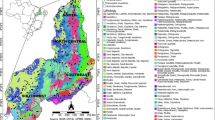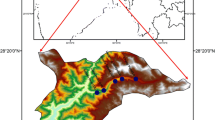Abstract
Purpose
Rare earth elements (REE) play a prominent role in the understanding of geochemical processes. Lanthanum (La) and neodymium (Nd) are considered as two representative examples of REE. The objectives of this study were to investigate their concentrations and spatial variability in coastal soils and to assess the effect of long-term reclamation. The coastal plain of Cixi City (China) has undergone reclamation for over 1000 years, providing an ideal place to perform such research.
Materials and methods
In total, 329 soils samples were collected by means of a nested sampling methodology, combined with grid and transect techniques. The total contents, as well as their diethylenetriamine penta-acetic acid (DTPA) extractable concentrations, were measured by an inductively coupled plasma-mass spectrometry (ICP-MS). Statistics and geostatistics tools were used to analyze their spatial variability. Combined variogram models were developed to quantitatively describe their spatial structure. Variance components were estimated to assess the proportion of their total variance captured by reclamation history and different sampling stages.
Results and discussion
Both the La and Nd concentrations showed great variability in space. Reclamation activity accounted for 42–84% of their total variance. There were significant differences in their contents between reclaimed zones (P < 0.05). They exhibited moderate spatial dependence, and the discontinuity in space generally occurred around sea dikes, as indicated by the spherical components of the La and Nd concentration variogram models. A gradually increasing tendency of elemental contents with reclamation time was observed, which was also reflected in the linear component of the variogram models. However, in the areas covered by the 3rd to the 10th zones, intensive application of phosphorus fertilizer, land consolidation, or household appliance factories led to large fluctuations of elemental contents being superimposed on the relatively homogeneous content distributions, thus causing the observed periodic features of their variogram models. Additionally, a 100-m sampling distance was found to be appropriate for future REE investigations.
Conclusions
Geostatistical modeling showed a great potential to analyze quantitatively the spatial variability of La and Nd and to assess human forces on soil genesis. The investigation of the spatial distribution of REE identified the prominent role played by the geogenic component. By means of spatial analysis, a time-series of elemental contents on a millennium scale was also reconstructed. Accumulation of their concentrations with time, as well as pollution, occurred in the surface soils. Reclamation history was the most important factor controlling La and Nd spatiotemporal variability.




Similar content being viewed by others
References
Aide MT, Aide C (2012) Rare earth elements: their importance in understanding soil genesis. ISRN Soil Sci 2012:1–11
Aubert D, Stille P, Probst A, Gauthier-Lafaye F, Pourcelot L, Del Nero M (2002) Characterization and migration of atmospheric REE in soils and surface waters. Geochim Cosmochim Acta 66(19):3339–3350
Brioschi L, Steinmann M, Lucot E, Pierret MC, Stille P, Prunier J, Badot PM (2013) Transfer of rare earth elements (REE) from natural soil to plant systems: implications for the environmental availability of anthropogenic REE. Plant Soil 366(1-2):143–163
Burgos P, Madejón E, Pérez-de-Mora A, Cabrera F (2006) Spatial variability of the chemical characteristics of a trace-element-contaminated soil before and after remediation. Geoderma 130(1-2):157–175
Cao X, Chen Y, Wang X, Deng X (2001) Effect of redox potential and pH value on the release of rare earth elements from soil. Chemosphere 44(4):655–661
Cambardella CA, Moorman TB, Parkin TB, Karlen DL, Novak JM, Turco RF, Konopka AE (1994) Field-scale variability of soil properties in central Iowa soils. Soil Sci Soc Am J 58(5):1501–1511
Chen L, Zhang G, Jin Z (2014) Rare earth elements of a 1000-year paddy soil chronosequence: implications for sediment provenances, parent material uniformity and pedological changes. Geoderma 230-231:274–279
Cheng H, Hao F, Ouyang W, Liu S, Lin C, Yang W (2012) Vertical distribution of rare earth elements in a wetland soil core from the Sanjiang Plain in China. J Rare Earths 30(7):731–738
Christakos G (1985) Modern statistical analysis and optimal estimation of geotechnical data. Eng Geol 22(2):175–200
Christakos G (1992) Random Field Models in Earth Sciences. San Diego, CA, pp 459
Christakos G (1998) Spatiotemporal information systems in soil and environmental sciences. Geoderma 85(2-3):141–179
Christakos G (2017) Spatiotemporal random fields: theory and applications. Elsevier, Amsterdam
Cixi Agricultural and Forestry Bureau, Zhejiang (1991) Agricultural chorography of Cixi. Shanghai Science and Technology Press, Shanghai, pp 11–32 (in Chinese)
Dołęgowska S, Migaszewski ZM (2013) Anomalous concentrations of rare earth elements in the moss-soil system from south-central Poland. Environ Pollut 178:33–40
Feng M, Shan X, Zhang S, Wen B (2005) A comparison of the rhizosphere-based method with DTPA, EDTA, CaCl2, and NaNO3 extraction methods for prediction of bioavailability of metals in soil to barley. Environ Pollut 137(2):231–240
Gee GW, Bauder JW (1986) Particle-size analysis. In: Klute A (ed) Methods of soil analysis. Part 1. Physical and mineralogical methods. ASA and SSSA, Madison, pp 383–411
Goovaerts P (1998) Geostatistical tools for characterizing the spatial variability of microbiological and physico-chemical soil properties. Biol Fertil Soils 27:315–334
Hao Z, Li Y, Li H, Wei B, Liao X, Liang T, Yu J (2015) Levels of rare earth elements, heavy metals and uranium in a population living in Baiyun Obo, Inner Mongolia, China: A pilot study. Chemosphere 128:161–170
Henderson P (1984) General geochemical properties and abundances of the rare earth elements. In: Henderson P (ed) Rare Earth Element Geochemistry. Elsevier, Amsterdam, pp 1–32
Hu Z, Haneklaus S, Sparovek G, Schnug E (2006) Rare earth elements in soils. Commun Soil Sci Plant Anal 37(9-10):1381–1420
International Society of Soil Science (ISSS) (1929) Minutes of the First Commission Meetings, International Congress of Soil Science 1927. Proceedings of the Congress of the International Society of Soil Science, Washington, pp 215–220
Kabata-Pendias A (2000) Trace elements in soils and plants, 3rd edn. CRC Press, New York
Lark RM (2012) Towards soil geostatistics. Spat Stat 1:92–99
Laveuf C, Cornu S (2009) A review on the potentiality of rare earth elements to trace pedogenetic processes. Geoderma 154(1-2):1–12
Laveuf C, Cornu S, Guilherme LRG, Guerin A, Juillot F (2012) The impact of redox conditions on the rare earth element signature of redoximorphic features in a soil sequence developed from limestone. Geoderma 170:25–38
Li X, Chen Z, Chen Z, Zhang Y (2013) A human health risk assessment of rare earth elements in soil and vegetables from a mining area in Fujian Province, Southeast China. Chemosphere 93:1240–1246
Liang T, Zhang S, Wang L, Kung H, Wang Y, Hu A, Ding S (2005) Environmental biogeochemical behaviors of rare earth elements in soil–plant systems. Environ Geochem Health 27(4):301–311
Lindsay WL, Norvell WA (1978) Development of a DTPA soil test for zinc, iron, manganese, and copper. Soil Sci Soc Am J 42(3):421–428
Loell M, Albrecht C, Felix-Henningsen P (2011) Rare earth elements and relation between their potential bioavailability and soil properties, Nidda catchment (Central Germany). Plant Soil 349(1-2):303–317
Lu H, Zhao X, Luo H, Li R, Zhu Y (2006) Soil fertility changes of cultivated soil in Cixi, Zhejiang. Chin Soil Sci 3:426–428 (in Chinese)
Ma C, Zheng R, Zhao J, Han X, Wang L, Gao X, Zhang C (2015) Relationships between heavy metal concentrations in soils and reclamation history in the reclaimed coastal area of Chongming Dongtan of the Yangtze River Estuary, China. J Soils Sediments 15:139–152
Miao L, Xu R, Ma Y, Zhu Z, Wang J, Cai R, Chen Y (2008) Geochemistry and biogeochemistry of rare earth elements in a surface environment (soil and plant) in South China. Environ Geol 56(2):225–235
Mihajlovic J, Stärk H, Rinklebe J (2014) Geochemical fractions of rare earth elements in two floodplain soil profiles at the Wupper River, Germany. Geoderma 228-229:160–172
Moiseenko TI, Skjelkvåle BL, Gashkina NA, Shalabodov AD, Khoroshavin VY (2013) Water chemistry in small lakes along a transect from boreal to arid ecoregions in European Russia: Effects of air pollution and climate change. Appl Geochem 28:69–79
Nelson DW, Sommers LE (1982) Total carbon, organic carbon, and organic matter. In: Page AL (ed) Methods of soil analysis. Part 2. Chemical and Microbial Properties. ASA and SSSA, Madison, pp 539–579
Nickel S, Hertel A, Pesch R, Schröder W, Steinnes E, Uggerud HT (2014) Modelling and mapping spatio-temporal trends of heavy metal accumulation in moss and natural surface soil monitored 1990-2010 throughout Norway by multivariate generalized linear models and geostatistics. Atmos Environ 99:85–93
Olea RA (1999) Geostatistics for engineers and earth scientists. Kluwer Academic Publishers, Boston
Pang X, Li D, Peng A (2001) Application of rare-earth elements in the agriculture of China and its environmental behavior in soil. J Soils Sediments 1:124–129
Pédrot M, Dia A, Davranche M, Gruau G (2015) Upper soil horizons control the rare earth element patterns in shallow ground water. Geoderma 239-240:84–96
Perelomov LV, Asainova ZS, Yoshida S, Ivanov IV (2012) Concentrations of rare-earth elements in soils of the Prioksko-Terrasnyi State Biospheric Reserve. Eurasian Soil Sci 45(10):983–994
Ramos SJ, Dinali GS, Oliveira C, Martins GC, Moreira CG, Siqueira JO, Guilherme LRG (2016) Rare earth elements in the soil environment. Curr Pollut Rep 2(1):28–50
Rankin PC, Childs CW (1976) Rare-earth elements in iron-manganese concretions from some New Zealand soils. Chem Geol 18(1):55–64
Saldaña A, Stein A, Zinck JA (1998) Spatial variability of soil properties at different scales within three terraces of the Henares River (Spain). Catena 33(3-4):139–153
Sun Y, Li X, Mander Ü, He Y, Jia Y, Ma Z, Guo W, Xin Z (2011) Effect of reclamation time and land use on soil properties in Changjiang River Estuary, China. Chin Geogr Sci 21(4):403–416
Tian B, Wu W, Yang Z, Zhou Y (2016) Drivers, trends, and potential impacts of long-term coastal reclamation in China from 1985 to 2010. Estuar Coast Shelf Sci 170:83–90
Tyler G (2004) Rare earth elements in soil and plant systems-a review. Plant Soil 267(1-2):191–206
Vodyanitskii YN (2012) Geochemical fractionation of lanthanides in soils and rocks: a review of publications. Eurasian Soil Sci 45(1):56–67
Wang L, Coles N, Wu C, Wu J (2014a) Effect of long-term reclamation on soil properties on a coastal plain, southeast China. J Coast Res 30(4):661–669
Wang L, Coles N, Wu C, Wu J (2014b) Spatial variability of heavy metals in the coastal soils under long-term reclamation. Estuar Coast Shelf Sci 151:310–317
Webster R, Oliver MA (2007) Geostatistics for environmental scientists. Chichester, UK, pp 77–138
Wei FS, Liu TL, Teng EJ, Rui KS (1991) Soil background value of rare earth elements of China. Environ Sci 12(5):78–82 (in Chinese)
Wei Z, Yin M, Zhang X, Hong F, Li B, Tao Y, Zhao G, Yan C (2001) Rare earth elements in naturally grown fern Dicranopteris linearis in relation to their variation in soils in South-Jiangxi region (Southern China). Environ Pollut 114(3):345–355
Wilding LP (1985) Spatial variability: its documentation, accommodation and implication to soil surveys. In: Nielsen DR, Bouma J (eds) Soil Spatial Variability. Pudoc, Wageningen
Xu C, Pu L, Li J, Zhu M (2019) Effects of reclamation on C, N, and P stoichiometry in soil and soil aggregates of a coastal wetland in eastern China. J Soils Sediments 19:1215–1225
Yan X, Kerrich R, Hendry MJ (1999) Sequential leachates of multiple grain size fractions from a clay-rich till, Saskatchewan, Canada: implications for controls on the rare earth element geochemistry of porewaters in an aquitard. Chem Geol 158(1-2):53–79
Yusoff ZM, Ngwenya BT, Parsons I (2013) Mobility and fractionation of REEs during deep weathering of geochemically contrasting granites in a tropical setting, Malaysia. Chem Geol 349-350:71–86
Zhang H, Feng J, Zhu WF, Liu CQ, Wu DS, Yang WJ, Gu JG (2000) Rare earth element distribution characteristics of biological chains in rare earth element high background regions and their implications. Biol Trace Elem Res 73(1):19–28
Funding
This work was supported partially by the Department of Science and Technology of Zhejiang (2016C04004) and by the National Natural Science Foundation of China (Grant NSFC 41671399).
Author information
Authors and Affiliations
Corresponding author
Ethics declarations
Conflict of interest
The authors declare that they have no conflict of interest.
Additional information
Responsible editor: Marcel van der Perk
Publisher’s note
Springer Nature remains neutral with regard to jurisdictional claims in published maps and institutional affiliations.
Rights and permissions
About this article
Cite this article
Wang, L., Christakos, G., Wu, C. et al. Spatial variability assessment of La and Nd concentrations in coastal China soils following 1000 years of land reclamation. J Soils Sediments 20, 1651–1661 (2020). https://doi.org/10.1007/s11368-019-02488-z
Received:
Accepted:
Published:
Issue Date:
DOI: https://doi.org/10.1007/s11368-019-02488-z




